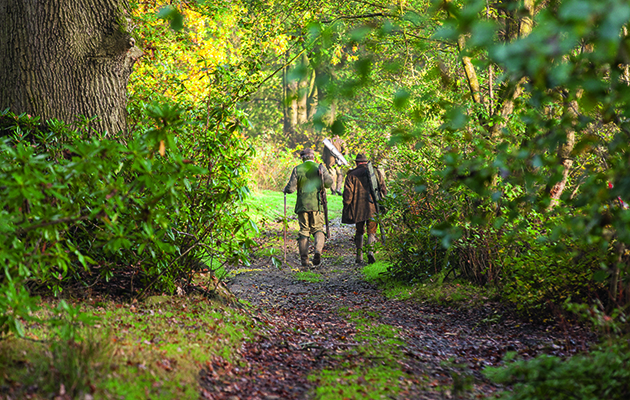Essential questions you should be asking about your sporting rights
What happens when a gentleman’s agreement over sporting rights doesn’t cut the mustard? By Rupert Bendell.

If you haven't got your sporting rights clearly defined as a landowner or shoot tenant, then you may well be heading for a gentlemanly disagreement, or worse
Reading through paperwork is seen by most of us as an inconvenience, a distraction, or an unwanted addition to our already busy lives. The only kind of paperwork that most of us enjoy lies between the covers of this magazine and tells tales of shooting exploits or fishing adventures. However, there are times when said paperwork can be a necessary evil. One example is an agreement for sporting rights.
How many of you reading this have ever seen one written down and how many have relied upon a ‘gentlemen’s agreement’? I suspect many of you will fall into the latter category, which is fine… until a gentlemen’s agreement becomes a gentlemen’s disagreement. As a land agent and chartered surveyor, I all too often see misunderstandings and worse occur as a consequence of the parties not having anything written down. So, if you rent sporting rights of any kind for the benefit of you and your shooting companions, or you let others shoot on your land, here are a few practical considerations to bear in mind:
1. What sporting rights are you talking about?
Firstly, one must consider what the parties are trying to achieve. Wild animals cannot be owned while they are alive and belong to the person on whose property they land once they are dead. Sporting rights can be owned/rented separately from the land itself and this, in legal speak, is called an ‘incorporeal hereditament’. An agreement for sporting rights therefore gives someone the right to enter onto another’s property, shoot what they find there and then remove it as their own.
However, for most organised shoots the right to simply shoot and remove quarry is not sufficient to cover all their activities, so consider including in any contract the ancillary rights and obligations that are required. Rights of access, rights of parking and rights to rear and release birds are simple but important and shouldn’t be forgotten. Are the rights to be granted on specific shoot days or throughout a year? How much game can be released and how many shot? Can vermin be shot and can rifles be used? Is the landowner/agricultural tenant happy for cover crops to be drilled, and if so, where and what type? Should the landowner be obligated not to do anything that may jeopardise the shooting activity or the welfare of the birds? Or conversely does the landowner need to reserve certain rights for the benefit of their farming activities or their tenant’s farming activities? Also one must consider that if the land is let (for example on a farm business tenancy), has the landlord reserved the sporting rights from the tenancy agreement to enable him to grant them separately?
2. To whom are you granting the sporting rights?
It is generally quite straightforward to identify the landowning party in any agreement for sporting rights, but to whom he or she is actually granting those rights can sometimes be a trickier question to answer. Consequently, who takes responsibility for the obligations in the agreement can be equally tricky to establish. The most straightforward solution is to identify a shoot owner or captain and have the agreement drawn up in their name. Alternatively, if a landowner wants to know precisely who will be granted the benefit of being able to shoot on their land, then perhaps including the names of all those in the syndicate (together with a gamekeeper and anyone involved in pest control on the land) is more appropriate. Whichever option is chosen, make sure it is clearly defined.
3. Where are the sporting rights being granted?
“Down in the fields by the river and in the big woods out the back,” accompanied by a finger-wag into the distance is a typical response to the question posed above, as there is often no map or plan that defines the area to be shot over. Drawing up a ‘red line plan’ is therefore a simple and useful exercise, but be mindful of whether it includes or excludes gateways, access tracks, buildings and suchlike. The plan will also clarify the acreage to be shot over and thus allow the parties to calculate a fairer licence fee or rent.
4. Who is responsible for what?
The fee/rent to be paid to the landowner, insurance, repairs to damaged property, interference with public rights of way, rent reviews and health and safety are just some of the considerations that need to be factored into any agreement. These are the areas that often go undiscussed in an oral arrangement and can be the origin of a dispute or misunderstanding. Also, be clear what legislation needs to be complied with, and it is often a good idea to attach the latest Code of Good Shooting Practice as a memorandum.
5. How long are you granting the sporting rights for and how can it be concluded?
Whether the agreement is going to be for several years, renewed annually or left on a rolling basis needs to be a discussion between the parties and it depends entirely on the circumstances. For example, if a shoot wants to invest in the land (say by erecting release pens or managing the woodland), a longer-term lease is going to be more appropriate than a seasonal arrangement. Part of this discussion ought to include how much notice either party needs to give to the other when terminating the agreement, and this will depend on practical considerations such as the removal of release pens and how growing cover crops are dealt with. In the absence of anything written down, the person who has been granted the sporting rights is entitled to ‘reasonable notice’.
When letting out land or property there is often much concern over granting ‘security of tenure’ to a tenant, ie. granting a tenancy that cannot be brought to an end easily or quickly, thereby preventing the landowner from recovering possession. In order to claim security of tenure, a tenant would usually need to prove that they enjoyed exclusive occupation of an area of land or a building for commercial purposes. On bare farmland this is not normally a cause for concern as the land is either occupied by the landowner or tenant farming it. Issues arise, however, where an agreement includes a building (a shoot hut used for lunch for example), which could be exclusively occupied. Therefore a landowner could choose to exclude it, or let it on a separate agreement, or use the building in tandem with the tenant in order to avoid exclusive occupation.
6. Don’t bury your head in the sand
With so much to consider, parties may often be tempted to bury their heads in the sand and ignore a written agreement altogether – increasing the risk of a dispute as a consequence. There is a raft of case law surrounding this topic so I would recommend having a document drawn up which is as clear as possible in the description of what each party can and cannot do – it could pay dividends and avoid those gentlemanly disagreements.
Rupert Bendell works for Wells McFarlane Chartered Surveyors








